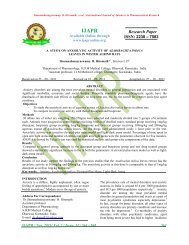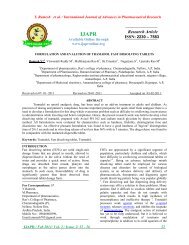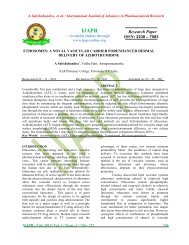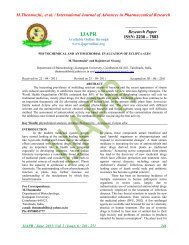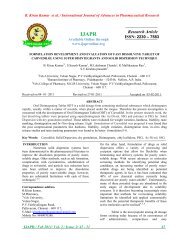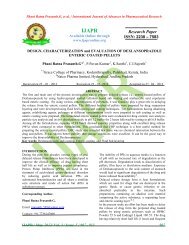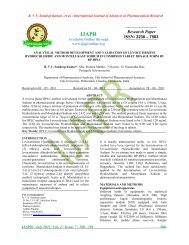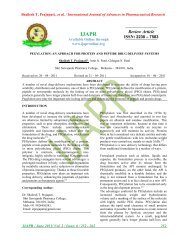ijapr - international journal of advances in pharmaceutical research
ijapr - international journal of advances in pharmaceutical research
ijapr - international journal of advances in pharmaceutical research
Create successful ePaper yourself
Turn your PDF publications into a flip-book with our unique Google optimized e-Paper software.
M.S Latha et al. / International Journal <strong>of</strong> Advances <strong>in</strong> Pharmaceutical Research<br />
liver (Fig.2B) is morphologically different from<br />
normal liver. In NDEA treated groups rat liver<br />
become very large <strong>in</strong> size and a large number <strong>of</strong><br />
hepatic nodules were observed <strong>in</strong> the liver. In MEWF<br />
200mg/kg treated group and <strong>in</strong> MEWF alone treated<br />
groups liver morphology is very similar to normal<br />
rats.<br />
3.3 Tissue biochemical analysis<br />
3.3.1 Estimation <strong>of</strong> Glutathione - S - transferase<br />
(GST)<br />
The GST activity <strong>of</strong> liver tissues were significantly (p<br />
≤ 0.05) reduced <strong>in</strong> NDEA <strong>in</strong>toxicated rats <strong>of</strong> pretreatment<br />
groups compared to normal control. The<br />
MEWF dose dependently <strong>in</strong>creased (p ≤ 0.05) the<br />
activity <strong>of</strong> GST <strong>in</strong> hepatic tissues (Table 1).<br />
Treatment with 200 mg/kg methanolic extract<br />
exhibited prom<strong>in</strong>ently <strong>in</strong>creased i.e., 89.9% GST<br />
levels. In addition, Silymar<strong>in</strong> treated rats also<br />
prevented the NDEA <strong>in</strong>duced decrease <strong>in</strong> GST<br />
activity by 69.9% <strong>in</strong> hepatic tissue.<br />
3.3.2 Estimation <strong>of</strong> Glutathione Reductase (GR)<br />
GR activity was significantly decreased (p ≤ 0.05) <strong>in</strong><br />
NDEA treated animals when compared to control. A<br />
significant <strong>in</strong>crease (p ≤ 0.05) <strong>in</strong> the level <strong>of</strong> GR was<br />
observed <strong>in</strong> MEWF (100 and 200 mg/kg) and<br />
Silymar<strong>in</strong> (100 mg/kg) treated rats <strong>in</strong>toxicated with<br />
NDEA (Table 1). The percentage <strong>of</strong> protection <strong>in</strong> liver<br />
tissue was 83.8% for 200 mg/kg <strong>of</strong> MEWF. Silymar<strong>in</strong><br />
restored the GR activity up to 62.6% <strong>in</strong> rat liver.<br />
3.3.3 Estimation <strong>of</strong> Glutathione Peroxidase (GPx)<br />
Activities <strong>of</strong> hepatic GPx was significantly (p ≤ 0.05)<br />
lowered <strong>in</strong> NDEA treated rats (Table 1). MEWF dose<br />
dependently prevented the lower<strong>in</strong>g <strong>of</strong> GPx<br />
compared to NDEA alone treated groups. In liver,<br />
200 mg/kg <strong>of</strong> methanolic extract showed a protection<br />
<strong>of</strong> 94.5%. Silymar<strong>in</strong>-treated rats also prevented the<br />
lower<strong>in</strong>g <strong>of</strong> GPx by 73.3% <strong>in</strong> hepatic tissues.<br />
3.4 Immunohistochemical analysis<br />
Fig. 3 and 4 shows the immunohistochemical<br />
analysis <strong>of</strong> PCNA and Cycl<strong>in</strong> D1 respectively. Here<br />
normal rat tissue showed regularly sta<strong>in</strong>ed nucleus.<br />
NDEA adm<strong>in</strong>istered rat liver tissue showed<br />
overexpression <strong>of</strong> Proliferat<strong>in</strong>g Cell Nuclear Antigen<br />
(PCNA) and Cycl<strong>in</strong> D1. Adm<strong>in</strong>istration <strong>of</strong> MEWF<br />
showed a reduction <strong>in</strong> the expression <strong>of</strong> PCNA and<br />
Cycl<strong>in</strong> D1. PCNA is a common <strong>in</strong>dex for<br />
proliferation <strong>of</strong> hepatocytes at late G1 stage and early<br />
S stage. Fig. 3B and 4B (HCC bear<strong>in</strong>g) groups<br />
sta<strong>in</strong>ed positively for PCNA and Cycl<strong>in</strong> D1<br />
<strong>in</strong>dicat<strong>in</strong>g active cell proliferation when compared<br />
with normal control. The plant extract given at a<br />
concentration <strong>of</strong> 200mg/kg showed a remarkable<br />
lower<strong>in</strong>g <strong>of</strong> the expression <strong>of</strong> PCNA and cycl<strong>in</strong> D1<br />
and was comparable to the effect rendered by<br />
silymar<strong>in</strong> at a concentration <strong>of</strong> 100mg/kg.<br />
4. DISCUSSION<br />
Abnormal proliferation <strong>of</strong> cells is the ma<strong>in</strong> feature <strong>of</strong><br />
carc<strong>in</strong>ogenesis, and there for exploration <strong>of</strong> drugs<br />
that can affect malignant proliferation <strong>of</strong> liver cells is<br />
<strong>of</strong> primary importance <strong>in</strong> chemical prevention <strong>of</strong> liver<br />
cancer. PCNA present <strong>in</strong> cell nucleus is directly<br />
<strong>in</strong>volved <strong>in</strong> DNA replication. It has been found that<br />
the positive expression <strong>of</strong> PCNA were a common<br />
<strong>in</strong>dex for proliferation <strong>of</strong> hepatocytes at late G1 stage<br />
and early S stage (20). The positive expression <strong>of</strong><br />
prote<strong>in</strong>s was ma<strong>in</strong>ly found <strong>in</strong> the precancerous<br />
proliferation focus and cancerous liver tissue dur<strong>in</strong>g<br />
NDEA <strong>in</strong>duced hepatocarc<strong>in</strong>ogenesis. The high<br />
expression <strong>of</strong> PCNA <strong>in</strong> the present studies suggested<br />
that the ability <strong>of</strong> cell proliferation become stronger,<br />
and this was closely related to malignant cell<br />
proliferation and carc<strong>in</strong>ogenesis (21). The results<br />
<strong>in</strong>dicated that the adm<strong>in</strong>istration <strong>of</strong> MEWF could<br />
remarkably decrease the PCNA <strong>in</strong> HCC bear<strong>in</strong>g<br />
tissue, suggest<strong>in</strong>g that MEWF had the ability to<br />
suppress malignant proliferation <strong>of</strong> hepatocytes <strong>in</strong><br />
experimental liver cancer and <strong>in</strong>hibited tumor growth<br />
through <strong>in</strong>hibition <strong>of</strong> DNA synthesis.<br />
Cycl<strong>in</strong> D1 is another important cancer marker has<br />
been associated with a variety <strong>of</strong> cancers <strong>in</strong>clud<strong>in</strong>g<br />
HCC. Cycl<strong>in</strong> D1 is the regulatory subunit <strong>of</strong> a<br />
holoenzyme that promotes progression through the<br />
G1-S phase <strong>of</strong> cell cycle. Amplification or<br />
overexpression <strong>of</strong> Cycl<strong>in</strong> D1 plays important roles <strong>in</strong><br />
the development <strong>of</strong> a subset <strong>of</strong> human tumorigenesis<br />
and cellular metastasis (22).<br />
Am<strong>in</strong>o transferases (AST, ALT) and GGT are the<br />
important cytoplasmic enzymes present <strong>in</strong> the liver.<br />
Dur<strong>in</strong>g chemical <strong>in</strong>toxication the membrane <strong>in</strong>tegrity<br />
is lost due to necrosis and these enzymes move <strong>in</strong>to<br />
the circulatory system followed by elevated levels <strong>of</strong><br />
enzymes <strong>in</strong> the serum (23). Increased levels <strong>of</strong> serum<br />
AST, ALT and GGT was detected <strong>in</strong> NDEA treated<br />
rats, effectively down- regulated by the treatment<br />
with MEWF <strong>in</strong>dicat<strong>in</strong>g the protective role <strong>of</strong><br />
Woodfordia fruticosa <strong>in</strong> NDEA <strong>in</strong>duced HCC.<br />
The <strong>in</strong>tra cellular antioxidant system comprises <strong>of</strong><br />
different free radical scaveng<strong>in</strong>g antioxidant enzymes<br />
such as GST, GR and GPx constitute the first l<strong>in</strong>e <strong>of</strong><br />
cellular antioxidant defense system. When excess<br />
free radicals are produced, the equilibrium is lost and<br />
consequently oxidative <strong>in</strong>sult is established (24).<br />
GST <strong>of</strong>fers protection aga<strong>in</strong>st lipid peroxidation by<br />
promot<strong>in</strong>g the conjugation <strong>of</strong> toxic electrophiles with<br />
GSH (25). GR is also essential for the ma<strong>in</strong>tenance <strong>of</strong><br />
IJAPR / Dec. 2012/ Vol. 3 /Issue. 12 / 1322 – 1330 1325



